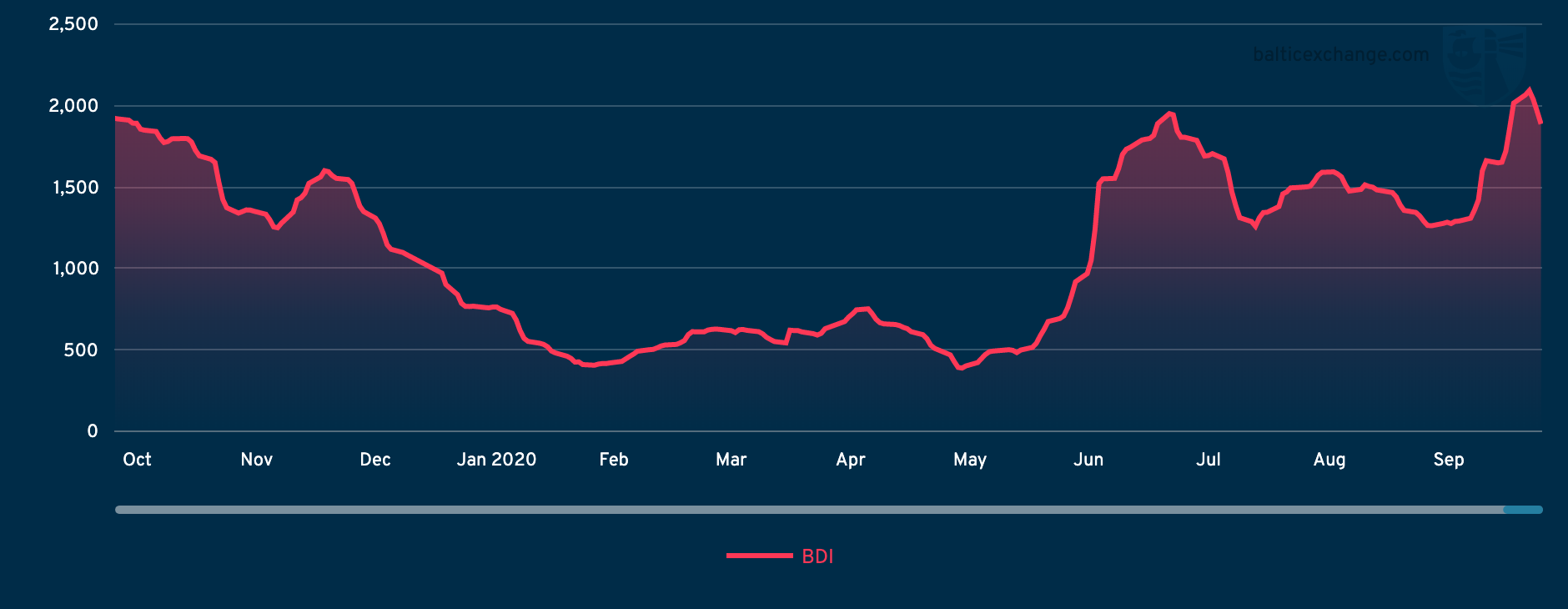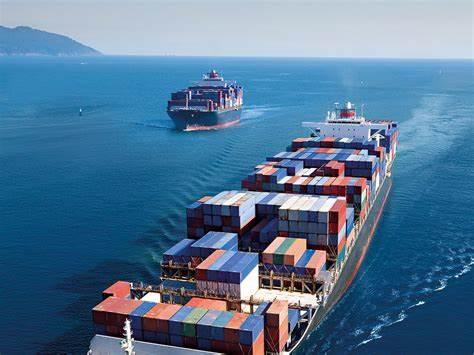BEIJING, Oct. 10 (Xinhua) -- The Baltic Exchange has published its weekly report of the dry and tanker markets for October 5-9, 2020 as below:
Capesize
The Capesize market reached new highs for the year this week, topping out at $34,896 on the 5TC. The quick ascension to these lofty heights has been met with an equivalent descent since Wednesday as the market shed value down to $29,479 by weeks end. Fixture activity has been sparse on the descent as charterers backed away and owners looked not to encourage further drops. The usual constant Pacific flow has ticked over, providing some firm insight into the market with the West Australia to China C5 route down Friday 0.496 to settle at $9.709. The recent large spread of the premium Transatlantic C8 over the Transpacific C10 opened the week at a whopping +$11,255 but has now contracted to +$5830. The Capesize market was short of typical participants this week as China took holidays. While China was back today, Republic of Korea took leave. With all the market back next week the fixture activity will surely increase providing more clarity on this Q4 market.
Panamax
The week evolved with the Panamax market gaining $56 on the week to return at $1439 The Atlantic market proved to be the biggest benefactor with the largest route movements as the north Continent tonnage count proved to be tight for most of the week and with solid demand of minerals and grains from the Baltic as well as US east coast. Rates duly rallied with $13,150 being agreed on an 82,000dwt for a US east coast round basis delivery Gibraltar. Elsewhere in the Atlantic, rates from South America nudged up. It was predominantly sentiment driven with talk of Cape Split cargoes carrying over into the market from last week, but by mid-week this interest appeared to have fizzled out. However, ample November grain stems continued to keep the market active. Holidays in China curtailed activity this week in Asia. But a robust NoPac market kept rates steady on the week with figures hovering around the low $12,000's levels for 82,000dwt delivery China.
Supramax/ Ultramax
With the Chinese holiday during much of the week, the Asian market remained rather subdued. Meanwhile, the Atlantic areas - such as the Continent - made gains with higher levels of enquiry. Period activity was limited but a 63,000dwt open China was fixed for a short period at $11,000. From the Atlantic, the Continent and west Mediterranean led the way. A 55,000dwt fixing delivery Morocco trip via Continent redelivery east Mediterranean in the mid teens. Better activity was seen mid week from the US Gulf, a 63,000dwt fixing a trans Atlantic run in the $17,000s. East coast south America remained subdued, with limited fresh enquiry and Ultramax size seeing mid teens for transatlantic business. Whilst Asia lacked impetus, the Indian Ocean saw increased activity. A 61,000dwt fixing delivery South Africa for a trip to east coast India at $13,500, plus $350,000 ballast bonus. A 63,000dwt also fixed delivery South Africa for a trip to China at $13,000 plus £$300,000 ballast bonus. All eyes on the up coming week to see what will happen further east.
Handysize
At the start of the week, both the BHSI and the time charter average declined for the first time since September. However, they recovered back to the positive territory in the second half of the week with the support from the US Gulf and Continent, despite east coast South America moving sharply lower. Meanwhile, the activity level remained low in the Pacific with China yet returning from the Golden Week holiday. From east coast South America, a 35,000dwt was fixed from Santos for a trip to Morocco at $9,000. A 36,000dwt open Pori was fixed for a trip via Baltic to the Continent at $18,000 and a 38,000dwt open Esbjerg was fixed for a trip to Sea of Marmara with scrap cargoes at $18,000. From the US Gulf, a 39,000dwt was fixed for a trip to UK Continent with pellets at $15,500.
Clean
The start of the week saw rates in the 75,000mt Middle East Gulf/Japan trade firm 7.5 points to WS75 and thereafter have held at this level. In the LR1 trade, a busier week saw owners able to push rates up - albeit by a modest 2.5 points - and the market has settled now at WS72.5. However, brokers feel that with little outstanding business and not a lot expected in the immediate fixing window, owners will struggle to achieve further increases.
At the start of this week the market for 37,000mt UKC/USAC stood at WS85 - but has since been under relentless downward pressure. WS75 was paid on tonnage with last cargo palms. The feeling is that even tonnage with a conventional clean last cargo background will find it difficult to achieve a premium here. The backhaul trade has been very quiet, with rates for 38,000mt from US Gulf to UK Continent drifting back down from WS72.5 region to barely mid WS60S. Meanwhile, in the US Gulf/Brazil trade, rates now sit at WS92.5 - down 12.5 points from the start of the week. The 30,000mt clean cross-Med trade had another miserable week with rates easing just over five points to barely WS70 level.
VLCC
Another week of mostly static rates. There were no changes in rates or sentiment in the Middle East with 280,000mt to USG via the Cape/Cape routing remaining assessed at a shade above WS17 and 270,000mt to China hovering around WS26.5. In the Atlantic, rates for 260,000mt West Africa to China are unchanged at WS30/31. Voyages of 270,000mt USG to China are valued at $4.8m, up about $200k from a week ago.
Suezmax
Rates for 135,000mt Black Sea/Med are again pegged at WS45. In the 130,000mt Nigeria/UK Continent market, charterers were able to snatch back 2.5 points to WS32.5 level. In the Middle East market sentiment remains depressed and 140,000mt Basrah/Med is now assessed at about W13.5 - almost a point less than a week ago.
Aframax
The 80,000mt Ceyhan/Med market remains rooted at WS57.5. In Northern Europe rates for 80,000mt Cross-North Sea eased a point or two to WS71.5 and 100,000mt Baltic/UKC lost five to six points to WS36.25. On the other side of the Atlantic rates for 70,000mt Carib/USGulf lost another six points to WS46 region and 70,000mt USG/UKC is now rated at WS40, down a further five points since last week.
Headquartered in London and a subsidiary of the Singapore Exchange (SGX), the Baltic Exchange publishes a range of indices and assessments which provide an accurate and independent benchmark of the cost of transporting commodities and goods by sea. These include the Baltic Dry Index (BDI), the dry bulk shipping industry's best known indicator. Published daily since 1985, this provides a snapshot of the daily spot market earnings of capesize, panamax and supramax vessel types on the world's key trading routes.

Chart shows Baltic Dry Index (BDI) during Oct.10, 2019 to Oct.9, 2020
In March 2018 the BDI was re-weighted and is published using the following ratios of timecharter assessments: 40 percent capesize, 30 percent panamax and 30 percent supramax. The information is provided by a panel of international shipbrokers.
(Source: The Baltic Exchange, edited by Niu Huizhe with Xinhua Silk Road, niuhuizhe@xinhua.org)




 A single purchase
A single purchase









